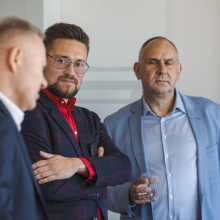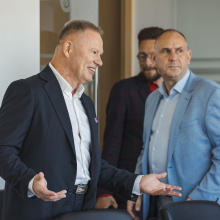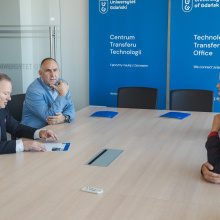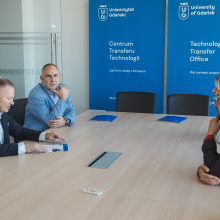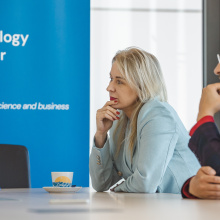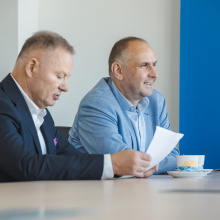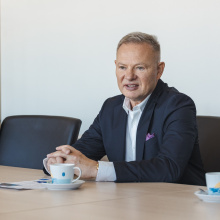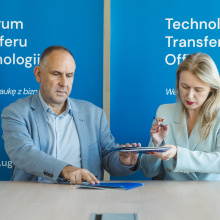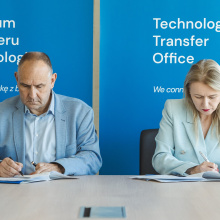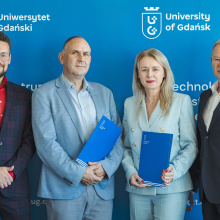An agreement has been signed for the sale of rights to an invention by scientists from the Faculty of Chemistry working under prof. Piotr Skowron. The subject of the invention is a method for obtaining butyrylcholinesterase enzyme (BChE) as a bioactive component of biosensors for the early detection of pesticide and Chemical Warfare Agent (CW) contamination. Negotiations preceding the signing of the agreement were led by the UG Technology Transfer Office team.
The agreement to sell the rights to the invention was signed between the University of Gdańsk and BIOANALYTIC, a company operating in the pharmaceutical and medical market for more than 25 years. The University of Gdańsk was represented by the Vice-Rector for Cooperation and Development, dr hab. Sylwia Mrozowska, prof. UG, while BIOANALYTIC was represented by Maciej Stopa , President of the Management Board . The meeting was also attended by the creator of the invention, prof. Piotr Skowron, and the Deputy Director of the Technology Transfer Office, Tomasz Chyrek.
The invention was the result of an NCRD research project aimed at solving the problem of early warning of pollution of water, agricultural crops, soil and air by organophosphorus compounds (OPs) and other toxic substances, including pesticides and CWs (chemical weapons), and developing countermeasures. According to the WHO, globally, 385 million people employed in agriculture contract acute pesticide poisoning each year, 250,000 of whom die. Water poisoning is also a serious problem, especially in agricultural areas. The use of CWs in armed conflicts and by terrorist organisations has also been recorded over the past 20 years.
In mammalian tissues, among others, there is an enzyme belonging to the serine hydrolases (which are the first line of defence against toxic compounds) - butyrylcholinesterase. The enzyme variant that is the subject of the invention is derived from molecular cloning of a fragment of the horse genome. The horse butyrylcholinesterase has approximately 250 times the activity of the human variant, hence it is an excellent choice for biosensor design.
The research team found a solution by developing advanced molecular cloning technology and isolating in an ultra-pure form the butyrylcholinesterase enzyme, a key component of biosensors for detecting the above-mentioned contaminants.
Butyrylcholinesterase destroys the poison in organisms. ‘It can act as an antidote to: OP pesticides, CWs (e.g. sarin, soman, novichok), plant alkaloids, animal venoms or drugs, e.g. cocaine. It can be a drug used in the treatment of a number of neurodegenerative diseases: dementia, alcoholism, drug addiction, Alzheimer's disease, traumatic damage to the nervous system,’ says the main inventor prof. dr hab. Piotr Skowron. The increase in sales in the biosensor market is mainly related to the emergence of new non-medical applications, the technological development of microfluidics, the increase in the number of chronic conditions requiring home diagnosis and the broadening of the spectrum of medical and non-medical applications. The cloned butyrylcholinesterase enzyme is characterised by the exceptional purity of a homogeneous protein preparation. ‘The technology offered enables the enzyme to be obtained in very high yields, with exceptional purity and at many times lower production costs compared to the traditional method of isolation from horse plasma. Moreover, as the enzyme is isolated from a recombinant microorganism , it does not raise ethical concerns, allows unrestricted access to the starting biological material and eliminates the danger of zoonotic disease infection,’ adds the professor.
‘Prof. Piotr Skowron's invention will be a platform for further development work in developing an even more efficient production of the enzyme. The development of a technology for highly efficient production of the protein is crucial in the creation of the final product,’ emphasised President Maciej Stopa.
Research was conducted as part of a consortium between the University of Gdańsk and the Medical University of Gdańsk. The project was led by the main developer, prof. Piotr Skowron from the Department of Molecular Biotechnology at the Faculty of Chemistry, working together with, among others, dr hab. Jacek Jasiecki from the Faculty of Pharmacy at the MUG. The invention has been granted patent protection in Poland and is also protected by a European patent. Such protection of the intellectual property of the solution significantly increases its value.
The research of the scientific team, headed by Prof. Piotr Skowron, received financial support from the 'Innovation Incubator +' programme of the Ministry of Science and Higher Education, which was administered by the Technology Transfer Office of the UG, including international patent protection. In addition, the project also financed pre-implementation work that raised the technological readiness of the invention, which further increased the chance of selling property rights and cooperating with business.
Innovations by scientists are increasingly becoming a support in the development of companies in the area of Research & Development and have a chance to be implemented in the market. This shows that closer collaboration between science and business in innovation is possible. This seems particularly important now that there is new funding for innovation and implementation projects together with entrepreneurs and research institutions.
The process of intellectual property protection and invention commercialisation has been coordinated by the UG Technology Transfer Office (TTO UG), a unit responsible for managing the university's intellectual property and the transfer of technologies developed at UG.
The Technology Transfer Office invites researchers who have not yet cooperated with the UG TTO but who are interested in innovation, patenting and commercialisation and would like to find out how these processes take place, to contact the TTO. Innovation brokers, legal counsel and patent attorneys support researchers throughout the process of intellectual property protection and commercialisation of inventions.

